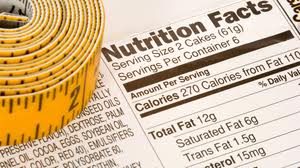Are you a calorie counter?
In the health and fitness world, one of the commonly proposed and supported strategies for weight loss is calorie counting.Have you used calorie counting to lose weight before? Has it worked for you? The readers I polled said they had had success with calorie counting , but they all threw in words like “quality vs. quantity”, “portion control”, and “label reading” – suggesting that they were, in fact, looking at a much larger nutritional picture.
The truth of the matter is that calorie counting, as a model, is too simplistic to address the complexity of each individual’s nutritional needs. Further, counting calories puts too much emphasis on the wrong things (quantity) instead of focusing on right things (quality).
With that being said, I’m going to tackle the calorie counting issue head on over the next four weeks. I’ll be discussing why calorie counting doesn’t work, what to do instead, and teach you what to focus on instead of just calories when reading food labels. But first, let’s lay some ground work, and get really clear on what a calorie is.
What is a calorie?
Purely scientifically speaking, a calorie is a measure of heat energy or “the energy needed to raise the temperature of 1 gram of water through 1 °C”. From a nutritional standpoint, a calorie is the amount of energy that is derived from a specific food or the amount of energy needed to metabolically “burn” a specific food. The term calorie or “Calorie” is routinely used in place of kilocalorie; food measurements are actually in kilocalories.
How is a calorie measured?
Here’s where things get kind of squirrely, so pay attention!
Originally, scientists would measure the number of calories in food by burning the food in a bomb calorimeter, a sealed container surrounded by water; the calories are measured by the resulting rise in water temperature. Using this method, a scientist named Atwater developed average calorie values for the macronutrients protein, carbohydrates, and fats.
Nowadays, the food industry typically uses an “indirect calorie estimation” method known as the Atwater system (based on Atwater’s standard values). Food calories are estimated based on the average caloric values for protein (4 kilocalories/gram), carbs (4 kilocalories/gram), and fats (9 kilocalories/gram). There are modifications to these values that have been made for some food groups including fruits, vegetables, and beans, but in general, the Atwater system provides the framework for estimating calories for packaged and restaurant foods.
One glaring omission in this process is fiber; often, to account for fiber, which is slow to digest, the amount of insoluble fiber is subtracted from the total carbohydrates. Unfortunately, insoluble fiber isn’t specifically listed on food labels, so replicating the calculations is tricky (says the girl who just pulled various items out of the pantry and tried to do just that).
As an example, here are the calculations for a handful of random items I pulled out of my cabinet.
**My apologies for this being so dang small!
Note, for most items the calories from the food label is in between the calculated calories and the calculated calories without fiber; I believe the discrepancy to be due to insoluble fiber, however, this cannot be confirmed.
Food for Thought
Next week, I’ll go more in depth about the limitations of counting calories, but based on what we’ve reviewed today, I want to pose two questions to you (and my thoughts on them).
Does your body operate like a closed-system furnace, like the calorimeter described above?
NO WAY. Your body is not a closed system. It’s a complex, adaptable, machine. In this respect, the calorimeter measurements are woefully inadequate in determining your body’s response.
Are you average?
HECK NO! Then what would make you think that using average burn rates (calories) to determine your body’s response will give you accurate results?
Leave your thoughts on calorie counting in the comments.

